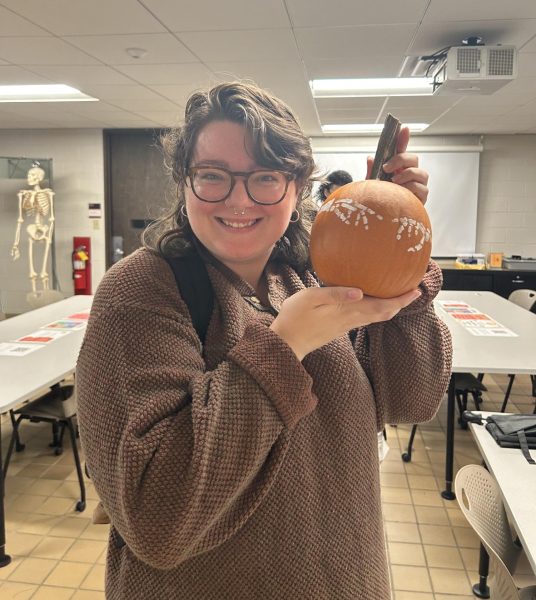Esports: An Insiders Guide to Esports both on and off Campus

December 4, 2020
Karl J. Zielezinski, 18, has been in love with video games since he was a kid. Before bed and after homework was his prime playing time where he was usually up late enough for his mom to tell him it’s time for bed. Zielezinskis main go-to was Nintendo games — Super Mario Galaxy, New! Super Mario Bros. Wii, Wii Sports, and games like Minecraft and Halo.
When booting up games from his past like Super Mario Galaxy, all of the memories from his childhood come flowing back, giving Zielezinski a warm, nostalgic feeling. As for other video games, they were his main way to connect with friends. His core friend group today is built upon
bonding over pixels on a screen.
It wasn’t until 2016 when Zielezinski started to play the tactical first person shooter, Counter-strike: Global Offensive (CS:GO) that began his interest in esports.
“The appeal for me was the esports combined sports competition with some of my favorite video games,” said Zielezinski.
Pre-COVID-19, Zielezinski would host his own esports competitions. Sending out a mass message through Instagram, he’d have about 20-to-30 people join him in his tiny home to play Super Smash Bros. The tournaments would usually be seasonal and during school breaks and guests were asked to bring extra switches or controllers if they had them, but Zielezinski already had most of the equipment already at his house.
In October of 2019, Zielezinski had his first video game competition when he attended Super Smash Bros Locals, a local tournament. (Local tournament) He had a lot of fun just like he does when he plays with his friends, and said that everyone at the competition was super-friendly.
“These tournaments made me realize that esports just wasn’t about the competition,” said Zielezinski. “but about making connections with other people, and having fun of course. I enjoyed being able to root for teams from the U.S who were competing against teams from all over the world.”
To get into the competitions, Zielezinski had to register himself for his team under which game he wanted to compete in, then the organizers of the teams and competitions would create the weekly matches in which you would participate.
Soon enough, high school came to an end and college was on the horizon. Zielezinski is currently a Buffalo State freshman with a major in Media Production. When first coming to college, Zielezinski was eager to find something to be a part of when he found the Buffalo State Esports organization.
Zielezinski simply typed “Buffalo State esports” into Google and found the organization. All he had to do after finding the organization was to sign up online and join the Buffalo State esports’ discord chat.
“I was able to register for the club,” said Zielezinski. “Talk to managers of the club, and get signed up for events like the SUNY League and monthly tournaments.”
In the grand scheme of esports — streaming plays a huge part. A lot of the popularity and success from esports is attributed to organizations streaming their official matches via Twitch. Esports athletes and personalities will sometimes stream their matches and practices to people and for the Buffalo State team, they stream almost everything on Twitch.
Zielezinski usually goes by “Kanjam” in the esports scene — keep your eyes out next time you play.
According to Grand view research, the global esports market was estimated to be $1.09 billion in 2019 and is expected to reach $1.48 billion in 2020. This projects that the global esports market will grow at a compound annual growth rate of 24.4% between 2020 and 2027 and is expected to reach $6.82 billion by 2027.
Nelson Phaphanthong, 19, started his interest in streaming about a year ago. Both Zielezinski and Phaphanthong would both love to pursue a career in gaming. Zielezinski is more interested in being a videographer (Content created), and/or commentator.
Like Zielezinski, Phaphanthong started playing as a kid and loved it. They would both enjoy making a living through video games — making money doing something they love.
Here’s how to get into streaming:
*Get some viewers: getting people who enjoy your stream enough to come back every time you stream is a go-to when first starting.
*Make a set schedule: making a set schedule allows your fans to be able to know when you’ll be streaming.
*Ads: when you start getting a steady stream of viewers you can get offered to run ads on your videos and receive commissions.
*Setting up a subscription: once you have everything established, you can set up a subscription for your viewers who will then pay a monthly fee to support your channel.
“Setting up donations is another way,” added Phaphanthong. “You can have some text-to-speech and the donor’s message will play aloud for everyone in the stream to hear.”
With playing video games and streaming comes video editing. Dylan Stoj, 19, started to get into video editing after watching endless amounts of YouTube growing up and now he mainly watches YouTube because of his video editing.
“The reason I still do it,” said Stoj. “It’s just because it’s fun to re-‘experience’ these funny moments with my friends and being able to look back is similar to a time capsule for me.”
To get into video editing — you need video editing software. There’s a ton of editing software out there, you’ll have the crazy-expensive programs that are more professional or the cheaper programs or apps that you can get on your phone. According to Stoj, getting into video editing isn’t the easiest thing to do because of just how much is out there, endless amounts of editing techniques and special effects you can add. With technology evolving so quickly with time — what you learn changes next time you go to edit.
If you’re really into video editing, you need to take it slow. If you go and take your time learning everything, it can be an easier process, you just have to be patient with the software and yourself.
“I know I still have a ton to learn about video editing and production,” added Stoj. “I’m still pretty new to it, but I know that it’ll be worth it to have as a skill in the future and it’s fun to do, as that’s a plus.”




